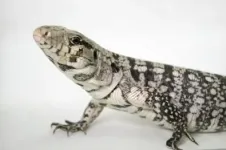South American lizard's blood pressure mechanism is more efficient at cool temperatures
The black and white tegu lizard, which depends on external environmental factors to regulate body temperature, can survive swings between 15 and 35 degrees Celsius in a single day while keeping blood pressure steady
2021-02-18
(Press-News.org) The mechanism that keeps arterial blood pressure stable in black and white tegu lizards (Salvator merianae) even as their body temperature varies substantially is more efficient at lower than higher external temperatures, contrary to what has always been believed, and vascular regulation plays a key role in pressure adjustments, according to an article published in PLOS ONE by researchers at the Federal University of São Carlos (UFSCar) in the state of São Paulo, Brazil. The research was supported by FAPESP.
The findings pave the way for more investigation of the physiology of ectothermic animals, which rely on external environmental factors to regulate body temperature, and of novel applications for the method used in the study.
“At some time, practically everyone feels dizzy on getting out of bed too quickly. The baroreflex is the mechanism that compensates for the sudden change in arterial pressure as blood in the lower part of the body, which flows at the same height as the heart while the person is lying down, suddenly has to flow against gravity when they get up. This kind of reflex is a feature of all vertebrates and is affected by temperature. It used to be thought that the increase in metabolism at higher temperatures enhanced the efficiency of the mechanism, but that’s not what we found in our study,” said Renato Filogonio, first author of the article and a researcher in the Department of Physiology at UFSCar’s School of Biological and Health Sciences (CCBS) with a postdoctoral scholarship from FAPESP.
The research was part of a project funded by FAPESP and with Cléo Alcantara Costa Leite, a professor at CCBS-UFSCar, as principal investigator.
“The baroreflex is an important mechanism that keeps pressure stable at the start of the circulatory circuit,” Leite said. “Blood pressure must be high at the start and low at the end of the system because the pressure difference is what drives the blood flow. Without blood flow, there’s no perfusion, which is the passage of blood through the tissues. The baroreflex is an adjustment mechanism, a reflex produced by the autonomic nervous system in all vertebrates to maintain homeostasis in the cardiovascular system.”
No drugs
Previous research showed that the efficiency of the baroreflex in reptiles and amphibians increases as the temperature rises, but heart rate alterations were measured after the use of drugs to raise or lower blood pressure in the studies in question. Here the animals were evaluated without the stress of pharmacological manipulation.
Furthermore, previous studies focused on compensatory baroreflex-related heart rate modulation, known as the cardiac branch, as this can be measured using the pharmacological method. The CCBS-UFSCar researchers analyzed the vascular branch, i.e. vascular resistance and compliance when aortic valves close, to find out if it helped the cardiac branch sustain cardiovascular homeostasis at low temperatures.
“It’s counterintuitive to observe that the cardiac branch of the baroreflex is less efficient at low temperatures because animals lower their heart rate as they cool down and fewer events are therefore needed to regulate blood pressure,” Filogonio said. “In this situation, the cardiac branch should be more efficient, not less, so we assumed there must be other mechanisms besides the cardiac branch that assisted pressure regulation at low temperatures and decided to investigate the vascular branch, which is ignored by most research in this field.”
Diastolic and systolic arterial blood pressure, heart rate, and pulse interval were measured via catheters implanted in 11 tegus and connected to pressure transducers. Measurements were taken at three temperatures: 15 °C, corresponding to mean nocturnal temperature; 35 °C, preferred for daytime activities; and 25 °C, corresponding to the midpoint between these two extremes.
“The results showed that in practice the baroreflex acts more efficiently when the temperature is falling, which is the opposite of what was previously believed. When the temperature is lower, heart rate is lower and compensations can’t rely only on this regulatory branch. That’s what happens in this case. The mechanism is made more efficient by vascular adjustments,” Leite said.
“The study is a good starting point for further research on the vascular branch of the baroreflex, focusing on comparative physiology, evolution or medical aspects, given that the method can easily be implemented in other animals,” Filogonio said.
INFORMATION:
About São Paulo Research Foundation (FAPESP)
The São Paulo Research Foundation (FAPESP) is a public institution with the mission of supporting scientific research in all fields of knowledge by awarding scholarships, fellowships and grants to investigators linked with higher education and research institutions in the State of São Paulo, Brazil. FAPESP is aware that the very best research can only be done by working with the best researchers internationally. Therefore, it has established partnerships with funding agencies, higher education, private companies, and research organizations in other countries known for the quality of their research and has been encouraging scientists funded by its grants to further develop their international collaboration. You can learn more about FAPESP at http://www.fapesp.br/en and visit FAPESP news agency at http://www.agencia.fapesp.br/en to keep updated with the latest scientific breakthroughs FAPESP helps achieve through its many programs, awards and research centers. You may also subscribe to FAPESP news agency at http://agencia.fapesp.br/subscribe.
[Attachments] See images for this press release:

ELSE PRESS RELEASES FROM THIS DATE:
2021-02-18
A new study concluding out of Lusaka, Zambia last summer has found that as many as 19% (almost 1 in 5) of recently-deceased people tested positive for COVID-19.
A new Boston University School of Public Health (BUSPH) study in Lusaka, Zambia's capital, challenges the common belief that Africa somehow "dodged" the COVID-19 pandemic.
The findings indicate that low numbers of reported infections and deaths across Africa may simply be from lack of testing, with the coronavirus taking a terrible but invisible toll on the continent.
Published in The BMJ, the study found that at least ...
2021-02-18
Neutralizing antibodies develop within two weeks of a SARS-CoV-2 infection, but their durability and intensity can vary by individual, prompting concerns about the prospects of long-lasting immunity and efficacy of COVID-19 vaccines.
In a PLOS ONE paper, published online February 11, 2021, researchers at University of California San Diego School of Medicine report that individual immune response to SARS-CoV-2, the virus that causes COVID-19, may be limited by the major histocompatibility complex or MHC, a set of variable genes that code for cell surface proteins essential for the adaptive immune system.
Specifically, ...
2021-02-18
Dreams take us to what feels like a different reality. They also happen while we're fast asleep. So, you might not expect that a person in the midst of a vivid dream would be able to perceive questions and provide answers to them. But a new study reported in the journal Current Biology on February 18 shows that, in fact, they can.
"We found that individuals in REM sleep can interact with an experimenter and engage in real-time communication," said senior author Ken Paller (@kap101) of Northwestern University. "We also showed that dreamers are capable of comprehending questions, engaging in working-memory operations, and producing answers. ...
2021-02-18
Dogs may be able to recognize their own body as an obstacle and also understand the consequences of their own actions, according to a study involving 32 pet dogs published in Scientific Reports.
Previous research has shown that dogs have complex cognitive capabilities, such as empathy and social learning, but whether they also show any form of self-awareness was not clear.
Péter Pongrácz and Rita Lenkei tested dogs in a 'body as an obstacle' task, during which the dogs had to pick up and give a toy to their owner, whilst standing on a small mat to which the toy was attached. In order to lift the toy, the dogs had to leave the mat.
The authors found that dogs left the mat more frequently and sooner when the ...
2021-02-18
The simplest of organic molecules have a much more complex relationship with oxygen than previously thought. Researchers from KAUST and their international collaborators have shown that alkanes participate extensively in autoxidation reactions with oxygen molecules1. The discovery, which overturns current chemical wisdom, has implications for air quality prediction and efficient fuel combustion in engines.
Autoxidation is a chemical process in which oxygen molecules rapidly and sequentially add to organic molecules in a radical chain reaction. The process is critical for ...
2021-02-18
New research published in Nature Food warns that heat stress in animals caused by rising temperatures and humidity will occur more frequently and for longer periods, impacting milk and meat productivity for dairy cattle, beef cattle, sheep, goat, pigs and poultry across East Africa.
Analysis of historical data from 1981-2010 shows that livestock have already been progressively subjected to heat stress conditions. According to projections, this is set to worsen significantly, with severe implications for livestock unable to cope with the extra heat.
Authors warn that 4-19% of current meat and milk production occurs in areas where dangerous heat stress conditions are likely to increase in frequency from 2071-2100. If climate conditions ...
2021-02-18
The gut microbiome is an integral component of the body, but its importance in the human aging process is unclear. ISB researchers and their collaborators have identified distinct signatures in the gut microbiome that are associated with either healthy or unhealthy aging trajectories, which in turn predict survival in a population of older individuals. The work is set to be published in the journal Nature Metabolism. (Once the embargo lifts, you can access the paper here.)
The research team analyzed gut microbiome, phenotypic and clinical data from over 9,000 people - between the ages of 18 and 101 years old - across three independent cohorts. The team focused, ...
2021-02-18
Shifting world views and putting nature at the heart of decision-making is key to achieving transformative change
COVID-19 recovery plans are an unmissable opportunity to invest in nature and reach net zero emissions by 2050
The world can transform its relationship with nature and tackle the climate, biodiversity and pollution crises together to secure a sustainable future and prevent future pandemics, according to a new report by the UN Environment Programme (UNEP) that offers a comprehensive blueprint for addressing our triple planetary emergency.
The report, ...
2021-02-18
As obesity becomes a growing issue worldwide - nearly tripling over the last-half century - scientists are trying to gain a better understanding of the condition at the molecular level. Now, new research led by UC San Francisco scientists suggests that a single protein could play an outsize role in weight gain.
As reported in Nature Metabolism on February 18, 2021, UCSF's Davide Ruggero, PhD, and colleagues found that mice in which activity of a protein called eIF4E is diminished, either genetically or pharmaceutically, gain only half the weight of other mice, even if all the mice eat a high-fat diet.
"These mice ...
2021-02-18
What The Study Did: Characteristics associated with posttraumatic stress disorder in patients after severe COVID-19 were analyzed in this observational study.
Authors: Delfina Janiri, M.D., of the Fondazione Policlinico Universitario Agostino Gemelli IRCCS in Rome, Italy, is the corresponding author.
To access the embargoed study: Visit our For The Media website at this link https://media.jamanetwork.com/
(10.1001/jamapsychiatry.2021.0109)
Editor's Note: The article includes conflict of interest disclosures. Please see the article for additional information, including other authors, author contributions and affiliations, financial disclosures, funding and support, etc.
INFORMATION:
Media ...
LAST 30 PRESS RELEASES:
[Press-News.org] South American lizard's blood pressure mechanism is more efficient at cool temperatures
The black and white tegu lizard, which depends on external environmental factors to regulate body temperature, can survive swings between 15 and 35 degrees Celsius in a single day while keeping blood pressure steady




